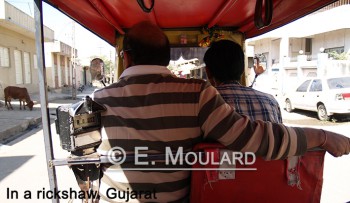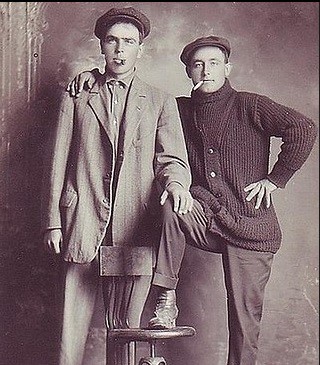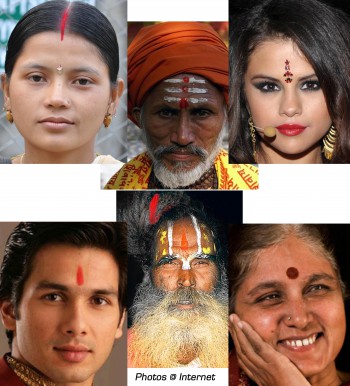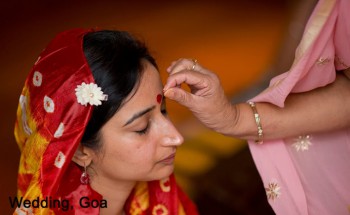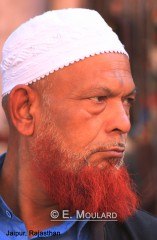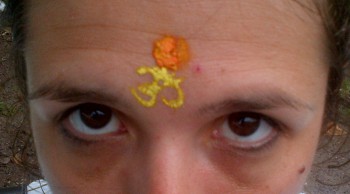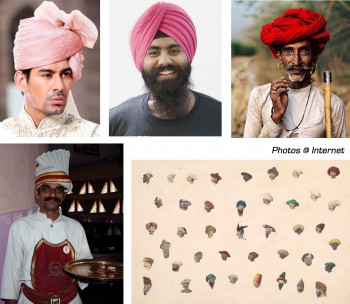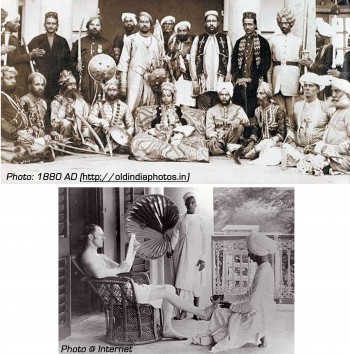10/16/2013
Why in India men hold hands?
Foreigners are always shocked to see Indian men strolling two by two, hand in hand... And even if I am used to it, seeing my new hired casually leave his hand on the thigh of a colleague he met the same morning, then lie back comfortably and pass his arm over the shoulders of the other guy, it still felt weird.
It is all the more surprising that men don’t behave like this with women at all…
So the first thing that comes to mind is that India explodes the ratios of homosexuality... But actually no, they are in the norm (1) (with admittedly a little more guys having ‘circumstantial’ homosexual sex since premarital sex is still a taboo – they do with whatever hole they get before they get married!). It was even considered an offence until 2010, when the Supreme Court observed that live-in relationships and premarital sex was nothing illegal (2). Until then, I remember that some hotels did not let us sleep together, my ex-favorite Indian and I, because we were not married and that the police could come down and arrest us for prostitution...
Similarly, the law does not specifically prohibit public displays of affection: the Penal Code of 1860 stipulates that “whoever, to the annoyance of others, does any obscene act in any public place, shall be punished with imprisonment of either description for a term which may extend to three months, or with fine, or with both” (3). But there is nowhere a definition of obscenity... (4).
The fact that it is legal doesn’t mean that it is morally well-accepted (5). It is even quite condemned... And the mentalities are changing, but not very fast... For example, more and more young people lose their virginity before marriage but they are forced to have sex in parks or on building roofs since it is out of question to bring someone of the opposite gender to your room...
Indians have a particular concept of ‘vital space’: it simply doesn’t mean anything. How many have I had a neighbour on a plane invading my space by overflowing the armrest? How many Indians sit on the lap of strangers in overcrowded buses or trains and it doesn’t bother anyone? How many families sleep six or more in a single room? Go try explaining the concept of ‘vital space’ in overpopulated cities... And what good would it do to them anyway?
And to make it simple, they like human contact. Period.
And if you look well, it’s been only a few decades than Western males no longer have much physical contact. This phenomenon would be linked to the rise of homophobia.
At the end of the nineteenth century, homosexuality began to emerge as an identity rather than just a practice: it evolved from something you would do (through the sexual act) to something you would be (a homosexual). Gradually homosexuals attracted more and more suspicion which culminated in a witch-hunt in the 1950s. And the more threatening homosexuals appeared the more that male bodies drifted apart: straight guys wanted to make sure that no one would believe they were gay. “The paranoia had replaced public affection.” (6)
Photo: www.artofmanliness.com
(1) http://www.indiansamourai.com/search/homosexualit%C3%A9
(3) Section 294 (a) of the Indian Penal Code, 1860
(4) The word 'obscene' has not been defined in the code. The laws are vague in that no. specific definition is laid down which could lead to arbitrary interpretation and in gross violation of freedom of expression enshrined in the Constitution of India
08:00 Posted in Why in India... | Permalink | Comments (0) | Tags: india, sex, public display of affection, pda, kiss, hug, vital space, homosexuality, holding hands | ![]() Facebook | |
Facebook | |
10/14/2013
Why in India people have red marks on the forehead?
Or, if we dig deeper, Who, when, how, where?
We can distinguish different ‘marks’: the dot in the middle forehead, the line at the root of the hair and the lines and other designs on the forehead. These marks are often red, but not always. It’s not easy to understand the whole thing!
So who wears what? Does a red dot mean a woman is married?
In North India, the red dot on the forehead would be traditionally the prerogative of married women. But not in South India. Anyway it has become a fashion element, which varies in shape, color and material (the sticker – top right photo – has been giving tough competition to the traditional bindi – bottom right).
It seems however that the sindoor applied at the root of the hair (top left) is only applied by married women (a way of saying don’t touch! – like others do with a ring!).
Men can also wear the tilak, for religious or aesthetic reasons.
In fact anyone (Hindu or not, man or woman, Indian or not) will bear a red mark on the forehead after attending a puja (religious ceremony): whether it's a small prayer at home or in the temple, it always ends by a marking on the forehead...
So... why?
Firstly for aesthetic reasons: Indians find it beautiful! Tastes and colors are not to be discussed...
Secondly the dot on the forehead is a Hindu religious symbol since the tilak, placed on the sixth chakra (‘agna’), represents the third eye or the eye of the mind, associated with deities and the concepts of meditation and spiritual enlightenment. It was originally exclusively for ‘knowledge holders’: idols, priests, ascetics. (1) The Vishnu worshippers’ tilak is a U of white color (obtained from sandalwood) drawn around a red or black line (bottom middle photo). And for Shivaites it is formed by three horizontal lines made from ashes (top middle). (2)
But above all there is a 'scientific' explanation: the body– the forehead and the point 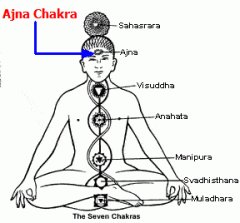 between the two eyes (seat of memory and thoughts) in particular – would produce energy in the form of electromagnetic waves. That’s how stress or anxiety creates heat and causes headaches. (1)
between the two eyes (seat of memory and thoughts) in particular – would produce energy in the form of electromagnetic waves. That’s how stress or anxiety creates heat and causes headaches. (1)
In Tantrism, during meditation, energy flows from the base to the head and leave the body by this point; hence the idea of "plugging the hole" to retain the energy inside. (3)
It is therefore to protect themselves and avoid energy losses that Hindus mark their forehead with a soothing and cooling powder paste.
Indeed, if the 'mark' varies in shape, colour, material and name ('tika', 'pottu', 'sindoor', 'tilak', 'tilakam', 'kumkum' and 'bindi', 'vermilion'), the traditional base (kumkum powder) is obtained by adding a few drop of lime to the yellow turmeric powder which then turns red (and add a little water to make it a paste). Some recipes contain saffron. And it turns out that both turmeric and saffron have medicinal properties as pain-killers! (4)
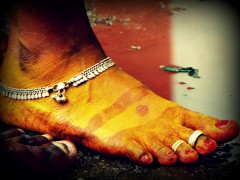 Turmeric is very present in the Indian culture. For example, in Andhra Pradesh, women used to apply it on (and under) the feet every day to protect them (because there were not too many shoes at the time (not that everyone wears shoes today either)). (5)
Turmeric is very present in the Indian culture. For example, in Andhra Pradesh, women used to apply it on (and under) the feet every day to protect them (because there were not too many shoes at the time (not that everyone wears shoes today either)). (5)
Indians may not have invented hot water* (not that they really need it anyways!) but their knowledge about medicinal plants is simply fascinating! Take henna. Not only is it cooling,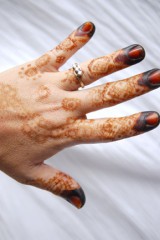 but also it is a coagulant for open wounds. Hence the tradition of Indian women to apply henna on their fingertips to protect themselves from the injuries inherent to manual chores. (6)
but also it is a coagulant for open wounds. Hence the tradition of Indian women to apply henna on their fingertips to protect themselves from the injuries inherent to manual chores. (6)
Here I owe an apology to my mother... After asking a thousand questions she came up with this one: “Tell me, why do these men have orange hair and beard?” I was a little bit upset with myself for not knowing the answer so I just told her whatever non-sense came to my mind: it is because they have used a bad quality dye which has faded!
In fact it seems that some men voluntary decide to have orange hair by dying it with henna. Apparently it could be because some Indians want to hide their gray hair but don’t have enough money to buy a good quality (black) dye. (7) The use of henna can also be linked to religion, as Islam would prohibit any dye except for henna. (8) When I asked my salesguy why do some people have orange hair he just told me that when people start to have gray hair they dye it, sometimes in black, sometimes in orange. No need to overthink it! You see Mum… ;)
* Sheer provocation?? Not only ! Apart from the zero, difficult to think of anything Indians actually invented… It doesn’t mean they are dumb though… They have stuff like the jugaad (in very short, “the gutsy art of overcoming harsh constraints by improvising an effective solution using limited resources”). Read more here.
(2) http://fr.wikipedia.org/wiki/Tilak
(3) http://hinduism.about.com/od/bindis/a/bindi.htm
(4) http://www.safrandugatinais.fr/en/vertus.htm; http://www.healthdiaries.com/eatthis/20-health-benefits-of-turmeric.html
(5) http://www.nandyala.org/mahanandi/?p=925
(6) http://www.ft.com/cms/s/0/d2933fb0-83de-11dc-a0a6-0000779fd2ac.html#ixzz2fW2qoFNh
(7) http://www.earthhenna.com/c158/c105/c98/The-Henna-Plant-c104.html
(8) http://ask.metafilter.com/88073/Why-would-a-Muslim-man-use-henna-to-dye-his-beard-orange
08:00 Posted in Why in India... | Permalink | Comments (0) | Tags: hair, hairs, beard, jugaad, innovation, orange, dye, henna, turmeric, saffron, spices, red dot, red mark, forehead, chakra, energy, meditation, third eye, tika, pottu, sindoor, tilak, tilakam, kumkum, bindi, agna, puja, kumkum powder, vermilion, orange hair | ![]() Facebook | |
Facebook | |
10/12/2013
Why in India some people don't cut their hair and wear a turban?
Sites dedicated to Sikhism explain that hair is a gift from God and therefore you don’t alter it (1). Moreover hair is beautiful (as any gift from God) then the longer the more beautiful.
That said, I am more and more convinced that any tradition or belief has a practical origin. As a matter of fact, if the Sikh religion appeared in 1469, emerging from the dominant religions (Hinduism and Islam), it is only in 1699 that cutting hair was forbidden (2). Now it so happens that at that time Sikhs were cornered: they had to give up non-violence (a founding principle of this religion) and take up arms against the Muslims who persecuted them (just as they were forcing Hindus to convert). As the Muslims wore beards – also certainly for practical reasons: “Act against the polytheists,” said Muhammad. “Carefully size your moustache and let yourself grow a beard.”(3) – and Hindus were moustachioed. To differentiate themselves (on the battle ground and otherwise) they had only two options left: leave it all or cut it all (but then it’s a lot of maintenance)...
And why the turban?
Long hair may be beautiful but it is not practical. Especially you are fighting and everything. Therefore, “the turban is in all respects a very convenient headgear; it is even more advantageous during war that our hats, because what they fall less easily, and can more easily prepare a blow of cutting edge”. (4) In addition it protects hair from the dust. And women can manage however they want (without a turban)...
But you must know that all turbaned men in India are not necessarily Sikh.
For example, the Rajasthani (top right) people, originally farmers and shepherds living in a mostly desert region, protect their head with a turban. Which varies in shape, size (even if it is usually 8-9 meter long (5)), material, colour and designs according to the wealth, caste and region of the wearer or the occasion.
Men wear turbans during weddings (top left).
And many janitors in big hotels or restaurants servers wear a turban (bottom left). In my opinion this practice dates from the colonial time when the Britishers must have found it classy to dress up their servants like that...
Morality, the turban does not (only) make the Sikh!
Subsidiary questions: How do Sikhs manage at the swimming pool with their turbans? How can Sikhs wear a helmet when on a bike? How do Sikhs pass airport security with their kirpan (dagger (2))?
At the pool, they take off their turbans but keep the piece of cloth th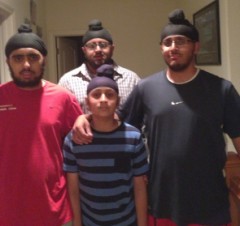 at covers their hair and makes them look like Smurfs and they avoid putting their head under water. Same thing when they play any sport.
at covers their hair and makes them look like Smurfs and they avoid putting their head under water. Same thing when they play any sport.
The regulation regarding helmet-wearing in India is a bit complicated, since it varies from one State to another. In Delhi for example, it is not compulsory for women to wear a helmet! And in Punjab and Haryana where there is a majority of Sikhs, wearing a helmet is simply optional. As a rule, Sikhs are not forced to wear helmets (which are too small to accommodate the turban!).
The Constitution of 1971 permits Sikhs to carry the kirpan in India. As for air-traveling, the kirpan is only allowed in a check-in luggage!
And why do all Sikhs bear the name Singh (men) and Kaur (women)?
Sikhism is an egalitarian religion, condemning discrimination based on gender or caste. Since in India, family names refer to caste, religion, region of origin, profession (yes all this! and it's hyper-complicated!), Sikhs use their ‘middle name’ as a surname. ‘Lion’ for men (Singh) and ‘Princess’ for women (Kaur).
But beware, the name Singh does not (only) make the Sikh.
There are people by the name Singh that are not Sikh. How to make things simple when they can be complicated? J
(1) http://www.realsikhism.com/index.php?subaction=showfull&id=1248365083&ucat=7
(2) Guru Gobind Singh (last of the 10 gurus who have developed the Sikh doctrine) has imposed the 5 kakas (5 K): hair and beard never cut (kesh) and retained by a comb (Adriana) symbolizing neatness, a metal bracelet (kara), military breeches (kachha) and a dagger (kirpan). Source: http://www.thecanadianencyclopedia.com/articles/fr/sikhisme; http://www.lemondedesreligions.fr/archives/2006/03/01/XVe-siecle-gourou-Nanak, 7928403.php
(3) http://www.slate.fr/lien/67915/barbe-moustache-monde-arabe
(4) http://alembert.fr/index.php?option=com_content & id = 640409723
(5) http://www.indianetzone.com/42/turbans.htm
Other sources: http://forums.Bharat-rakshak.com/viewtopic.php?p=600509 ; http://www.fashion.arts.AC.UK/media/research/documents/toolika-Gupta-effect-of-British-Raj-on-Indian-costume.PDF
08:00 Posted in Why in India... | Permalink | Comments (0) | Tags: india, hair, religion, sikh, turban, long hair, beard, moustache, turbaned, sikhism, islam, hinduism, guru, gobind singh, five kakas, kakas, rajasthani, name, singh kaur, warriors, kirpan, airport, motorcycle, helmet, sport | ![]() Facebook | |
Facebook | |















